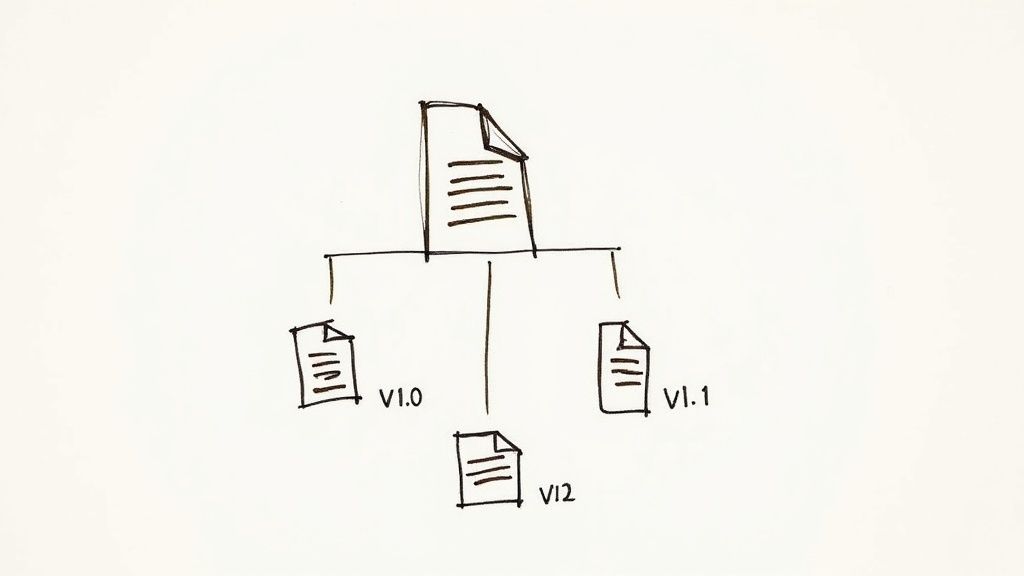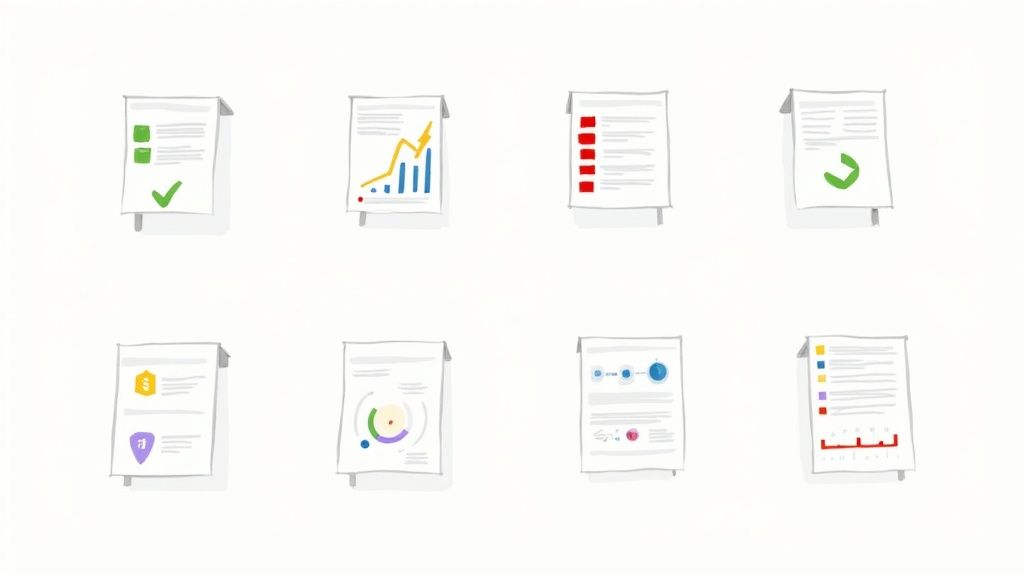
We've all been there. You're searching for a critical project brief and find Brief_v3_final_JDs_edits.docx. A sigh of relief. But an hour later, someone uploads Brief_v3_final_final_USE_THIS_ONE.docx to the same shared folder.
This isn't just a minor annoyance; it's a perfect snapshot of a hidden, productivity-killing problem. It’s the exact issue that document version control software was built to solve.
The Hidden Costs of Unmanaged Documents

Without a real system in place, document management spirals into chaos. Fast.
Imagine a marketing team gearing up for a huge product launch. The proposal, the budget spreadsheet, and the creative brief are all floating around in a shared drive. You have a copywriter, a designer, and a project manager all dipping in and out, making edits simultaneously.
The result? A complete mess of conflicting versions. The designer ends up working from an old brief, the copywriter's final, approved text gets accidentally overwritten, and the project manager burns hours just trying to figure out which file is the right one. This isn't just frustrating; it's a direct hit to your bottom line.
The Real Price of Document Chaos
This digital disorganization comes with very real business costs that go way beyond simple frustration. When your team doesn't have a single source of truth, the fallout can be felt across the entire company.
- Wasted Hours: Your team ends up burning valuable time just trying to find the right file or manually merging changes from three different documents. In fact, some studies show professionals can spend up to 50% of their time just looking for information, and a huge chunk of that is wasted on tracking down the correct version of a document.
- Costly Mistakes: Acting on outdated information is a recipe for disaster. Think about a sales team using an old price list or a legal department referencing a contract clause that's been superseded. These aren't small slip-ups; they can lead to real financial losses and seriously damage client relationships. A practical example: a construction company works from an old blueprint version pulled from a messy folder, leading to a foundation being poured in the wrong dimensions, costing tens of thousands in rework.
- Compliance Risks: For any business in finance, healthcare, or law, having a clean, clear audit trail isn't a "nice-to-have"—it's non-negotiable. Without proper version history, proving compliance during an audit becomes a nightmare, potentially leading to massive fines and legal headaches.
This kind of chaos creates operational friction that quietly eats away at your efficiency. It's not just about cleaning up messy file names; it's about protecting your business's integrity and making sure things run smoothly.
On top of these immediate challenges, messy processes are a form of business debt. Many organizations are already dealing with the consequences of uncovering the hidden cost of technical debt and legacy software, where outdated systems create problems that only get worse over time. Manual document management is no different.
Ultimately, working without a structured system keeps your team in a constant state of reaction, always putting out fires instead of pushing projects forward. This is where implementing document version control software changes the game. It gives you the framework to move from chaos to clarity, turning a huge liability into a powerful operational asset. It's about finally establishing a reliable process for tracking changes, preventing conflicts, and creating one definitive history for every document.
What Is Document Version Control and Why It Matters

Think of document version control as a dedicated time machine for your most important files. It’s a methodical way of managing the endless drafts and revisions a document goes through, from its first word to its final sign-off. The system tracks every single change, giving you a crystal-clear history of who did what, and when.
At its heart, document version control is all about creating a single source of truth. It’s the cure for the common headaches of team collaboration: accidental overwrites, conflicting edits, and the sheer chaos of figuring out which "Final_Contract_v3_final_final.docx" is the actual final version.
This isn't just a nice-to-have. For businesses in tightly regulated spaces like legal, healthcare, or finance, a complete and verifiable audit trail isn't just good practice—it's a requirement. Version control delivers that transparent history, letting you prove compliance and trace a document's journey at a moment's notice.
More Than Just File History
It’s easy to look at the "version history" feature in tools like Google Drive or Dropbox and think you've got version control covered. While those logs are helpful, they’re fundamentally different from what dedicated software offers. Basic history is passive; it just records what happened. True version control is an active management system.
A proper document version control software provides a much more robust framework. It introduces critical features that simple file history just can't match:
- Controlled Check-In/Check-Out: This "locks" a document when someone is working on it. No more two people editing the same file at once and creating conflicting versions.
- Structured Approvals: It builds formal review and approval workflows directly into the process, so you know every document has been properly vetted. For example: A legal team using a tool like SmartSuite can trigger an approval workflow where a junior associate drafts a contract, which then automatically locks and notifies a senior partner for review before it can be sent to a client.
- Advanced Conflict Resolution: When overlaps do happen, these systems have tools to help you intelligently merge different versions without losing anyone's work.
- Granular Security: You get precise control over who can view, edit, or approve certain documents or even specific versions.
A dedicated version control system moves you from passively observing changes to actively managing them. It’s the difference between having a simple logbook of a ship’s journey and having a captain, crew, and navigation system to steer it safely to its destination.
This distinction is crucial. While these concepts originally came from the world of software development, they've been specifically adapted for business documents. If you're curious about the roots, checking out a comprehensive guide to version control in Git provides a great look at how developers use these principles.
The demand for these tools is on the rise because more businesses are realizing their value. Forecasts show the document version control software market is set to grow at a compound annual growth rate (CAGR) of 8% through 2031. This growth is fueled by the need for regulated workflows and clear audit trails.
Ultimately, putting a proper version control strategy in place is a massive step up for your business operations. It goes hand-in-hand with other efficiency gains, like using document automation software to cut down on manual errors and build smoother workflows from beginning to end.
Essential Features of Top Version Control Systems

So, you're ready to ditch the chaos of shared folders and messy file names. That's a huge step. But before you jump into the first platform you see, it's critical to know what to look for in a document version control software. They aren't all created equal.
The best systems have a specific set of features that do more than just store files. They're designed to stamp out errors, lock down sensitive information, and make teamwork feel effortless. These aren't just flashy add-ons; they are the core functions that turn your document workflow from a frustrating liability into a dependable business asset.
To help you sort through the options, here’s a quick breakdown of the core features you'll find in quality version control software and what they actually mean for your day-to-day operations.
Core Features in Document Version Control Software
Now, let's dig a little deeper into what makes each of these features so indispensable.
Automated Versioning
The most fundamental feature is automated versioning. This is what finally frees you from the tyranny of manual file naming—no more Report_v1, Report_v2, Report_FINAL_for_real_this_time.docx. Every time a document is saved or a significant change is made, the system automatically creates a new, numbered version.
This one function is a game-changer. It brings instant consistency, ends the confusion caused by human error, and guarantees a logical, chronological history for every single file.
Practical example: An engineering firm uses this for its technical drawings. When an engineer updates a blueprint in their system, it automatically archives the old version and logs the new one as Blueprint_A451_v3.1. This simple act prevents hugely expensive construction mistakes that happen when teams build from outdated plans.
Check-In and Check-Out Systems
Think of a check-in/check-out system as your first line of defense against conflicting edits. It’s an absolute must-have for any collaborative team.
When a team member "checks out" a document, it becomes locked and read-only for everyone else. This brilliant little feature prevents two people from making changes at the same time and accidentally wiping out each other's work. Once they're done, they "check in" the document, which unlocks it and makes the new version available for the next person.
It’s just like a library book system for your digital files. You can't have two people borrowing the same physical copy of a book at once. A check-out system enforces that same discipline, bringing order to the editing process.
Detailed Audit Trails
Ever needed to know who approved a document and when? A robust audit trail gives you the answer. It provides a complete, unchangeable record of every single action taken on a document.
This log captures who viewed, edited, downloaded, or approved a file, complete with a precise timestamp for each activity. For any business concerned with compliance and accountability, this level of transparency is non-negotiable. It offers irrefutable proof of a document's history, which is priceless during internal reviews or external audits.
Practical example: A finance team is in the middle of a yearly audit. The auditor wants to see proof of when a specific financial policy was approved. With a detailed audit trail, the team can pull up the document's history in seconds and show the exact date, time, and user who gave the final sign-off. Request satisfied, instantly.
Role-Based Access Controls
Not everyone on your team needs access to everything. Role-based access controls (RBAC) are what let you define precisely who can do what with your documents.
You can set incredibly granular permissions, giving some users view-only access while others get full editing or approval rights. This is vital for protecting your most sensitive information.
- Securing Sensitive Data: Keep prying eyes away from confidential HR records, financial statements, or legal contracts. For example, in a Noloco client portal, you can set permissions so that clients can only view their own signed contracts, while account managers can view all contracts for their assigned clients, and legal can view and edit all contracts company-wide.
- Maintaining Integrity: Ensure only qualified people can change official policies or standard operating procedures (SOPs).
- Simplifying Workflows: Users only see the documents and actions relevant to their jobs, which cuts down on clutter and the potential for mistakes.
Conflict Resolution Tools
Even with a great check-out system, there are times when you might need to merge different edits. This is where conflict resolution tools come in handy.
When two versions of a document have competing changes, the software can highlight the differences side-by-side. This visual comparison allows a user to review the conflicting sections and decide which changes to accept, reject, or combine. It’s a crucial safety net that ensures no valuable work gets lost during complex projects.
Comparing Document Version Control Software Options
Choosing the right document version control software is a bit like picking a vehicle. A sleek sports car is perfect for a race track, but you wouldn't use it for a cross-country move. The best tool for your team really depends on your specific needs, team size, and the workflows you already have in place.
Some platforms are all about simplicity and collaboration, while others are built like fortresses, offering enterprise-grade security and strict compliance features. Let's break down some of the most common options to see where they shine and how they might fit into your work, especially when you're using tools like Airtable, Zapier, or ClickUp.
General-Purpose Collaboration Platforms
For many small businesses, the first step into version control happens with the tools they’re already using every single day. Platforms like Google Workspace and Microsoft 365 are the natural starting point for millions.
- Google Workspace (Google Drive): Famous for its dead-simple interface and real-time collaboration, Google Drive’s "Version history" is often the first taste of versioning people get. It’s fantastic for simple documents and brainstorming sessions where everyone needs to jump in at once.
- Microsoft 365 (SharePoint & OneDrive): SharePoint takes things up a notch with more structured and robust versioning than Google Drive. It brings in features like check-in/check-out and more detailed permissions, making it a solid pick for any company already deep in the Microsoft world.
Here’s a look at the familiar Google Drive interface, where version history is a lifesaver for tracking who changed what and when.
While seeing a file's history is useful, it's more of a passive record than an active management system. This is where dedicated software really starts to show its value.
When you're ready to get more serious than just basic history tracking, it's a good idea to see what else is out there. As you explore, you might want to look at a range of platforms, including those recognized as Top Document Workflow Software.
Specialized and Developer-Centric Systems
Beyond the usual office suites, there's a whole other class of tools that grew out of the software development world. Their interfaces can feel a bit more technical, but the principles they're built on are the absolute gold standard for version control.
The idea of version control systems (VCS) has been around for over 50 years. Early systems in the 1980s laid the foundation, but the game really changed in 2005 with the creation of Git. This new distributed system fundamentally reshaped how teams manage not just code, but any kind of document. Its growth has been staggering—with 93.87% of developers expected to use Git by 2025, it’s undeniably the industry standard. This journey from simple file tracking to essential infrastructure shows just how powerful modern versioning can be. You can dive deeper into this history and the popularity of various version control systems on RhodeCode's blog.
Git-Based Platforms (GitHub, GitLab): Even though they were designed for code, these platforms are powerful enough to manage any type of document. They offer incredible features for branching (creating parallel versions to work on), merging changes back together, and tracking every single modification with pinpoint precision. For technical teams or projects that demand ironclad change management, these are the top contenders.
The learning curve for Git-based systems can be pretty steep for non-technical folks. But their power to connect with other tools is almost endless. For example, a development team could use Zapier to automatically create a new task in ClickUp whenever a document in a GitHub repository is updated, seamlessly bridging their technical work with project management.
Comparison Table Key Differences
To make a smart choice, it helps to see these options laid out side-by-side. The right decision often comes down to finding that sweet spot between ease of use and the need for more powerful features.
Practical Example: A marketing agency might start with Google Docs for drafting ad copy because it's so easy to collaborate. As they grow, they could switch to SharePoint to manage client contracts and proposals, using its check-in/out feature to stop people from overwriting each other's work. If they start developing their own marketing automation scripts, they might use GitLab to manage that code, integrating it with Airtable to track campaign results tied to specific script versions.
At the end of the day, the best document version control software is the one that slides into your team's current way of working while giving you the security and structure you need to keep growing.
How to Automate Document Versioning
 While having a dedicated document version control software is a huge step forward, the real magic happens when you bring automation into the mix. Manually checking files in and out or updating version numbers still leaves the door wide open for human error. The goal is to connect your data sources directly to your file storage, creating a seamless, error-proof workflow right from the start.
While having a dedicated document version control software is a huge step forward, the real magic happens when you bring automation into the mix. Manually checking files in and out or updating version numbers still leaves the door wide open for human error. The goal is to connect your data sources directly to your file storage, creating a seamless, error-proof workflow right from the start.
This is where the right tools can completely transform your team's day-to-day. By integrating a document automation platform with the apps you already use, you can finally say goodbye to tedious manual steps and guarantee consistency across every single file you create.
Connecting Your Data to Your Documents
The core idea here is brilliantly simple: let triggers in your business apps automatically create perfectly formatted and named documents. Tools like DocsAutomator act as the bridge, listening for specific events in one system—say, a project's status changing in Airtable—and then using that cue to instantly build a new document.
Let's look at a real-world example. Imagine a consulting firm that runs its entire project pipeline through an Airtable base.
The Scenario: A new client project just got the green light. The team needs to generate a formal project charter, populate it with the client's info from Airtable, name it correctly, and save it to a shared Google Drive folder. Easy, right?
Instead of a project manager manually copying and pasting data, fighting with formatting, and hoping they remember the correct naming convention, automation can knock out the entire process in seconds.
This approach doesn't just save a ton of time. It also lays the foundation for perfect version control by ensuring the very first version of a document is created flawlessly, every single time.
A Practical Automation Workflow with Airtable and Zapier
So, how does this actually work? Here’s a step-by-step breakdown of how you could set this up using a popular no-code stack.
- The Trigger: It all begins in Airtable. A project manager updates a record in their "Projects" base, switching the
Statusfield from 'Pending' to 'Approved'. This one little change kicks off the entire automation. - The Action (Zapier): A Zapier "Zap" is patiently watching for this exact status change. The moment it sees an "Approved" project, it fires off the next step in the workflow.
- Document Generation (DocsAutomator): Zapier grabs the project data from that Airtable record and passes it over to DocsAutomator. DocsAutomator then takes all that info—client name, project scope, budget, key milestones—and populates a pre-designed project charter template in Google Docs.
- Automated Versioning and Saving: As part of the process, DocsAutomator automatically names the new file based on a pre-set rule, like
Project_Charter_ClientX_v1.0.pdf. It then saves this freshly generated, perfectly versioned PDF directly into the correct client folder in Google Drive.
This whole sequence unfolds automatically, with zero manual effort required. The result is a consistent, reliable process that removes all the guesswork from creating documents. Version 1.0 is always perfect, giving you a clean, solid starting point for any future edits or reviews.
You can learn more about how to automate document generation and build powerful workflows like this one for your own business.
Implementing Version Control Best Practices
Getting your hands on a powerful document version control software is the easy part. The real work—and where you’ll see the biggest payoff—is getting your team to actually use it correctly. Technology is just one piece of the puzzle; your success hinges on building solid processes and getting everyone on the same page.
Without a shared game plan, even the most advanced software can lead right back to the chaos you were trying to escape. A practical implementation plan is what turns a team's workflow from reactive and messy to structured and reliable. This goes way beyond just sending out a login link; it demands a thoughtful approach to both people and process.
Establish Clear Naming Conventions
Even with systems that automatically track version numbers, a consistent naming convention is your first line of defense against confusion. A good file name gives you context before you even open the document.
You need to create a simple, logical Standard Operating Procedure (SOP) for how files are named. The key is to make it easy to remember and apply across every project and department.
Practical Example Naming Convention:[ProjectName]_[DocumentType]_[Status]_[DateYYYY-MM-DD].ext
Odyssey_Campaign-Brief_Draft_2024-10-26.docxOdyssey_Ad-Copy_Approved_2024-11-05.pdf
This structure makes it instantly obvious what a file is and where it is in the process, which cuts down on the mental heavy lifting for your team.
Define User Roles and Permissions
Before anyone even logs in, you have to decide who can do what. Role-based access control is a cornerstone of version control, but it’s completely useless without a plan. Take the time to map out the roles on your team and assign permissions that make sense.
- Viewers: Can only read documents. This is perfect for stakeholders who need to be kept in the loop but shouldn't be making changes.
- Editors: Can check out documents, make edits, and save new versions. This is for the core team members who are actively doing the work.
- Approvers: Have the final say. This role is usually reserved for managers or senior team members who have the authority to sign off on a document.
By setting these boundaries from day one, you protect sensitive information and prevent rogue changes from derailing your projects. This is a cornerstone of effective document lifecycle management, ensuring a document's journey from draft to archive is secure and controlled.
Create a Formal Approval Workflow
A document isn't really "final" until it's been properly reviewed and approved. Your implementation needs a clearly defined workflow for how this happens. This simple step eliminates bottlenecks and the dreaded question, "So... is this ready to go?"
Practical Example: Marketing Team Workflow in ClickUp:
- Draft: A copywriter finishes the first version of a campaign brief in a Google Doc attached to a ClickUp task. They change the task status to
Ready for Review. - Review: This status change automatically assigns the task to the Marketing Manager, who reviews the brief. They can add comments and change the status back to
In Progressor move it forward. - Approval: Once all edits are done, the manager changes the task status to
Approved. - Distribution: A Zapier or API-driven automation triggers, creating a read-only PDF of the final brief and saving it to a shared drive, while also notifying the design team's Slack channel.
This kind of structured process ensures every asset is properly vetted, which is how you maintain quality and consistency across the board.
Provide Effective Team Training
Finally, don't just throw your team into the deep end and assume they'll figure it out. Host a dedicated training session that covers both the "how" and the "why."
Walk them through the software, sure, but spend more time explaining why these new habits matter. Use real-world examples from their own work to show them the problems you're solving—like preventing two people from overwriting each other's work on a press release or ensuring everyone is using the latest sales proposal. When your team truly gets the benefits, they'll be much more willing to embrace the change.
Frequently Asked Questions
When you start digging into document version control software, a few questions always seem to pop up. Let's tackle some of the most common ones so you can get moving in the right direction.
Can I Just Use Google Drive for Version Control?
It's a fair question. After all, tools like Google Drive and Dropbox have that "version history" feature. But relying on that is like having a passive security camera instead of an active security guard.
Google Drive’s history is great for seeing past changes, but that’s where it stops. A real document version control software is much more hands-on, giving you powerful features that cloud storage just can't offer:
- Check-in/Check-out: This is a game-changer. It "locks" a file when someone is working on it, which means no more two-people-editing-at-once-and-overwriting-each-other's-work nightmares.
- Formal Audit Trails: This creates a bulletproof, unchangeable log of every single action—who viewed a file, who edited it, who approved it, and exactly when. For any kind of compliance, this is non-negotiable.
- Structured Approval Workflows: Instead of chasing people down on Slack or email for a sign-off, you can build a formal review process right into the system. This ensures every document is properly vetted before it’s finalized. For example, in a platform like Glide, you can build a simple app for your team that shows a list of documents awaiting their approval, with buttons to "Approve" or "Reject" that trigger the next step in the workflow.
Simply put, these platforms give you a degree of control and security that basic cloud storage history was never designed for.
Is This Software Hard for Non-Technical Teams to Use?
That’s a completely valid worry, especially if your team’s eyes glaze over at the mention of new software. The good news? The days of clunky, engineer-focused version control systems are mostly behind us. Modern document version control software is built with everyday users in mind, featuring clean, intuitive interfaces.
The secret to getting your team on board isn't about the tech; it's about the "why." You have to show them how this new system solves their biggest headaches—no more lost work, no more confusion over which file is the real final version.
To make the transition painless, start with a super simple workflow and give them some hands-on training. Most people get the hang of it fast once they realize it makes their jobs easier, not harder.
What Is the First Step to Implementing Version Control?
The temptation is to try and fix everything at once, but that's a recipe for disaster. The best way to get started is to think small and build from there.
Here's a simple game plan:
- Pick One Critical Project: Don't try to boil the ocean. Choose a single, high-stakes project where versioning problems are causing the most chaos. For example, focus only on the client onboarding process that uses your Airtable or SmartSuite base.
- Map Out a Simple Workflow: For that one project, define the basic steps. Who needs to review the documents? Who gives the final thumbs-up? Keep it dead simple.
- Train Only the Core Team: Get the handful of people directly involved in that project up to speed. They'll become your champions who can help everyone else later.
- Expand Based on What You Learn: Once you've ironed out the kinks and seen what works, you can start rolling the system out to other teams with confidence.
This gradual approach keeps the implementation from feeling overwhelming and sets your whole team up for success in the long run.
Ready to stop chasing down file versions and start building flawless, automated workflows? With DocsAutomator, you can turn data from Airtable, Glide, ClickUp, and more into perfectly formatted documents in minutes. Take control of your document creation process and try DocsAutomator for free today!







